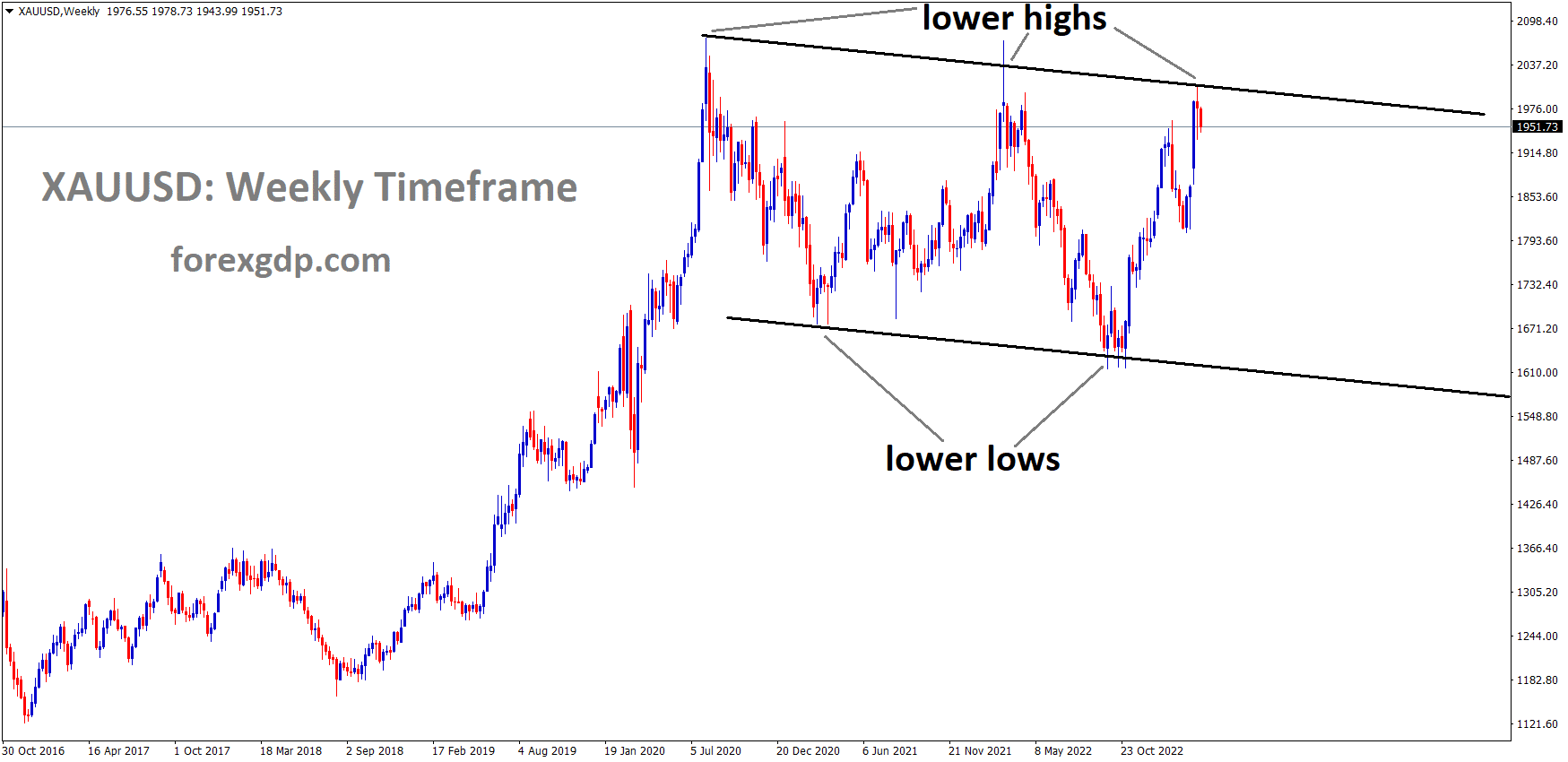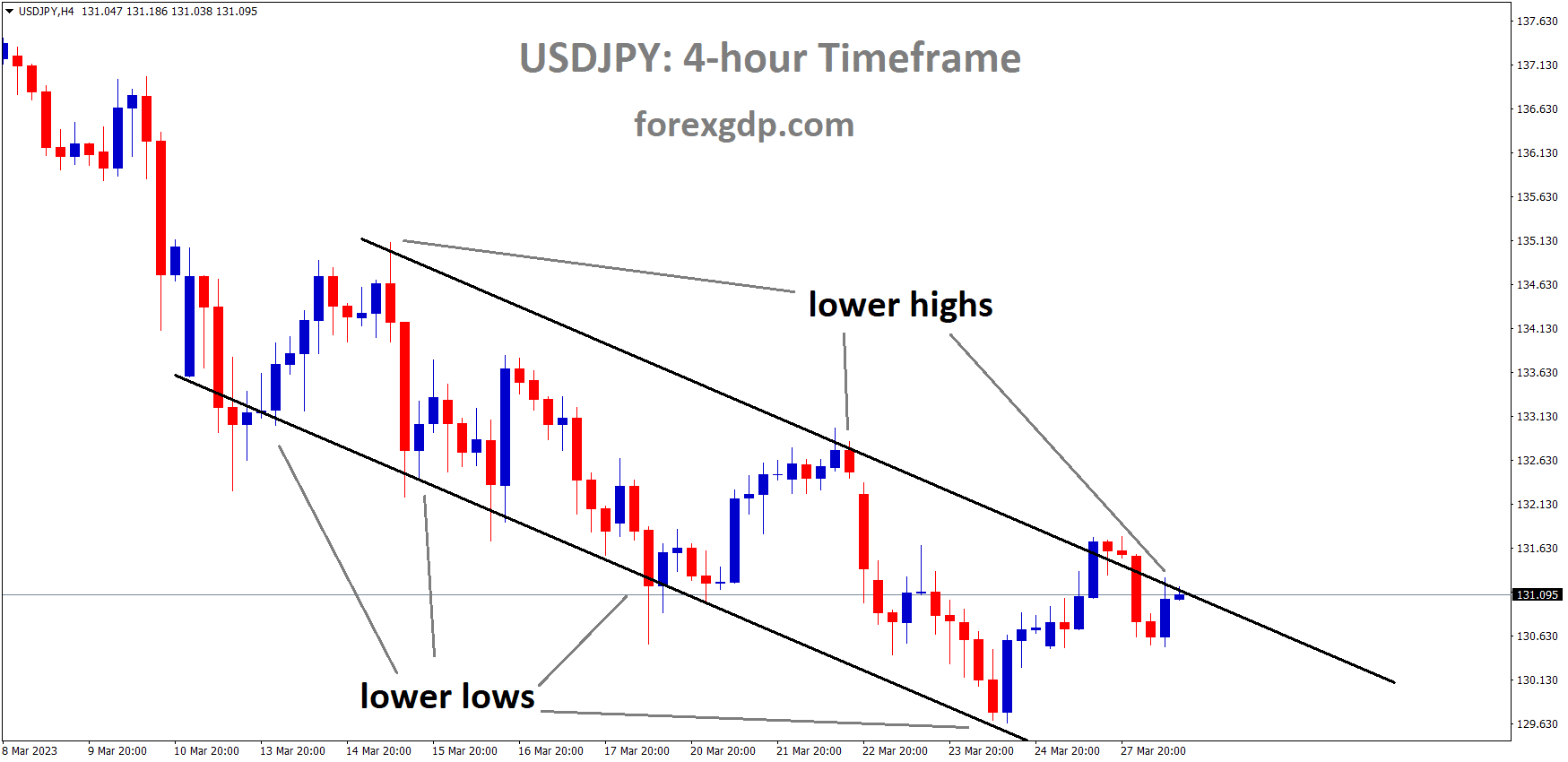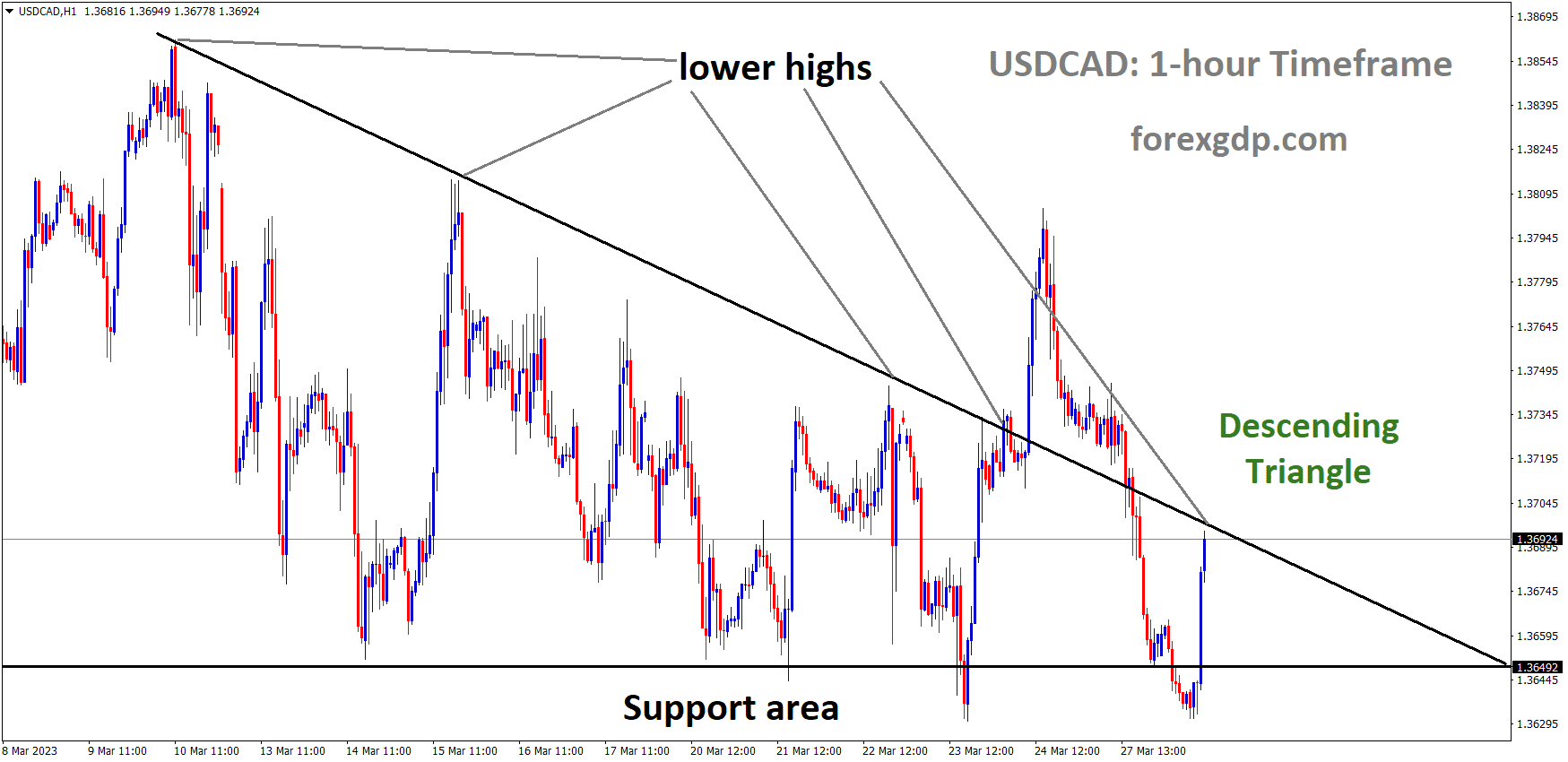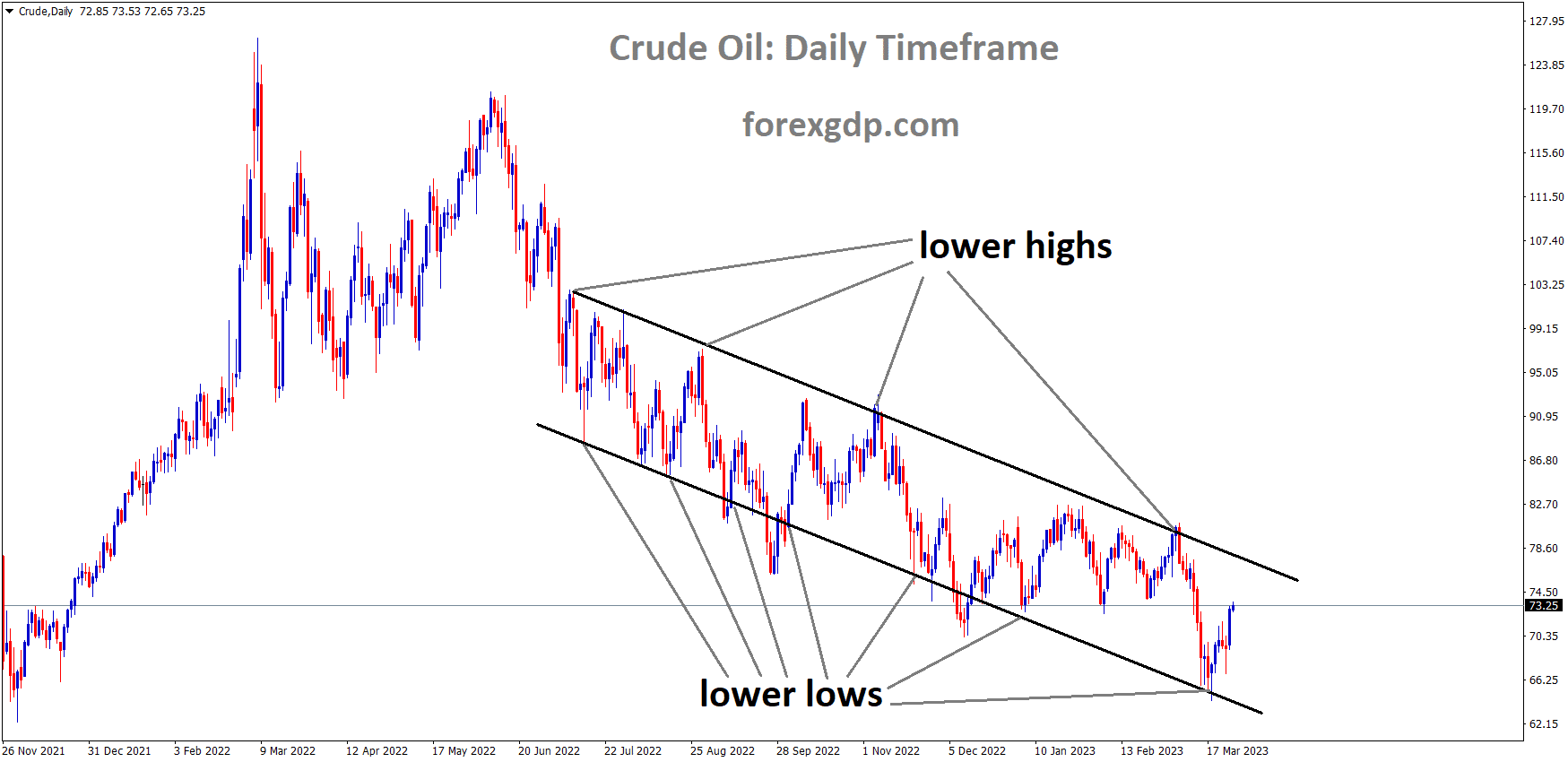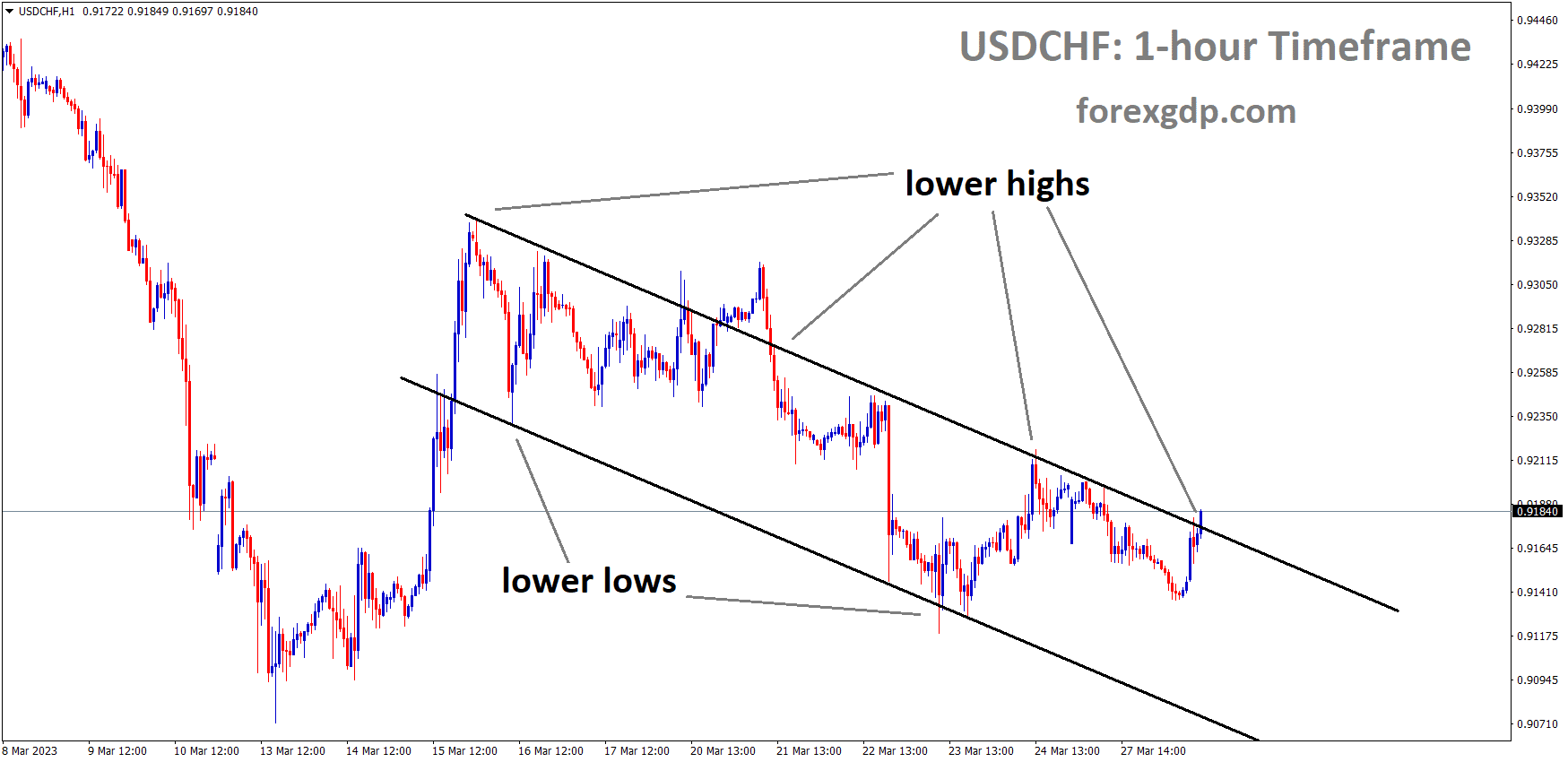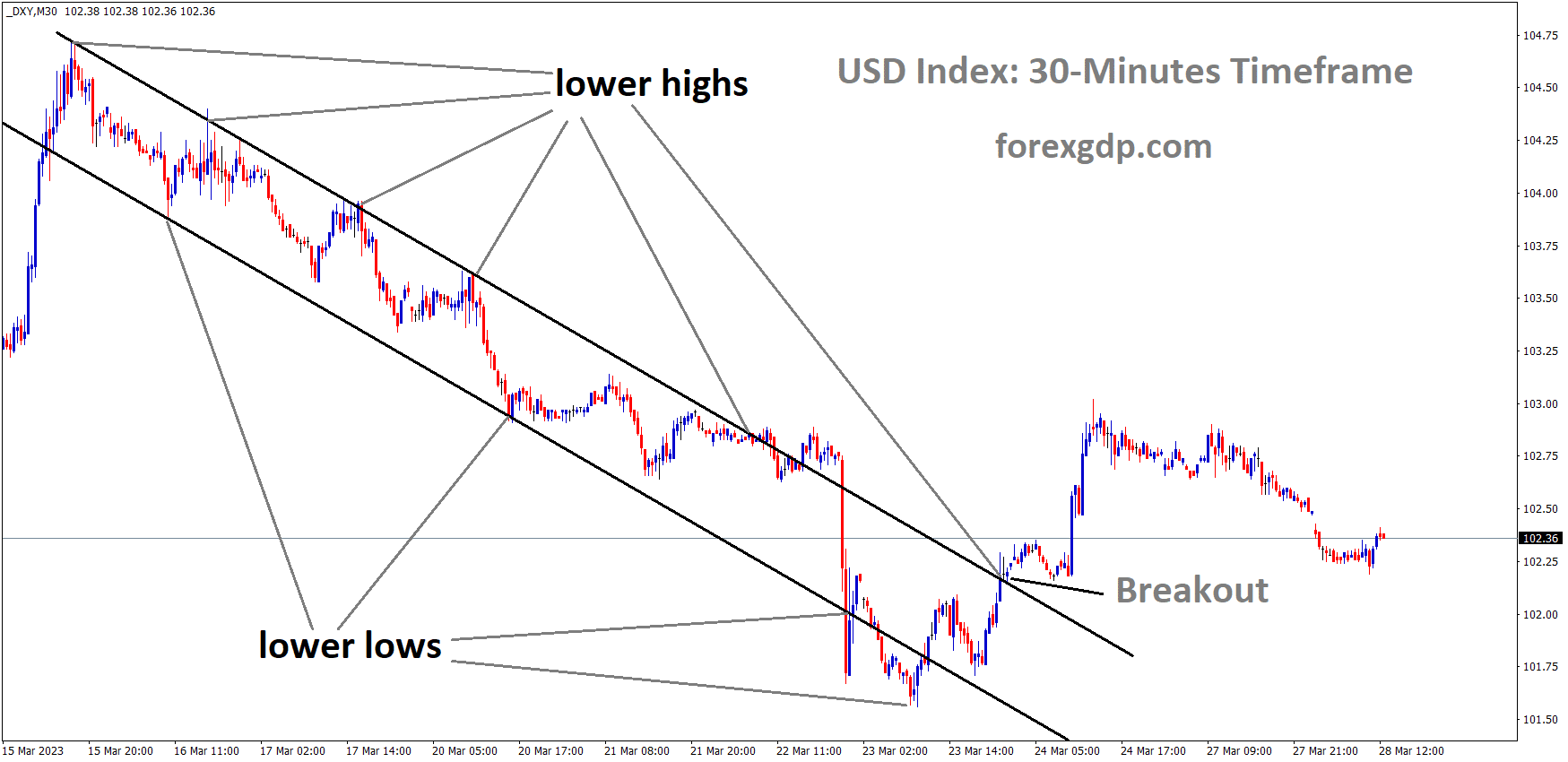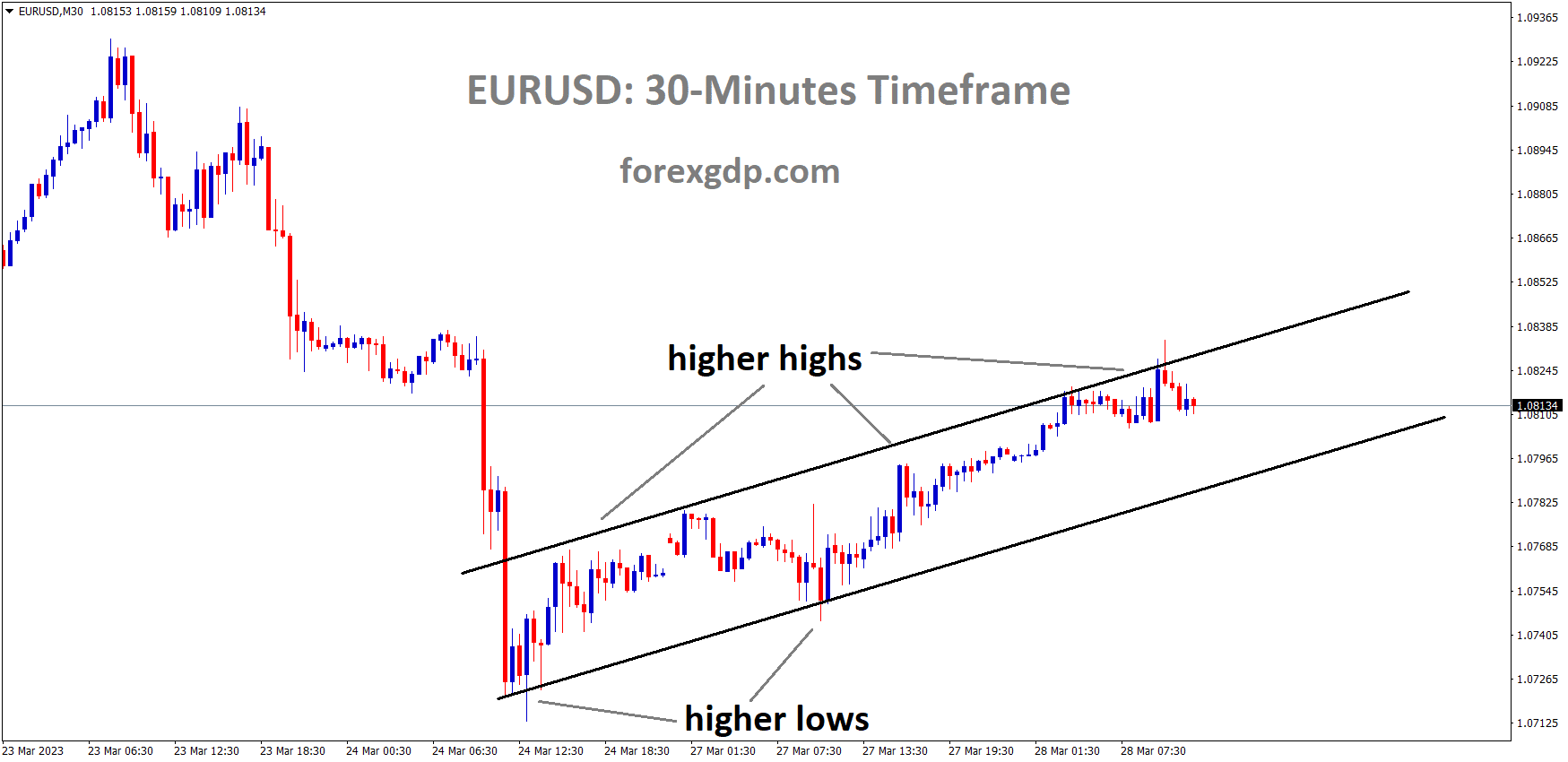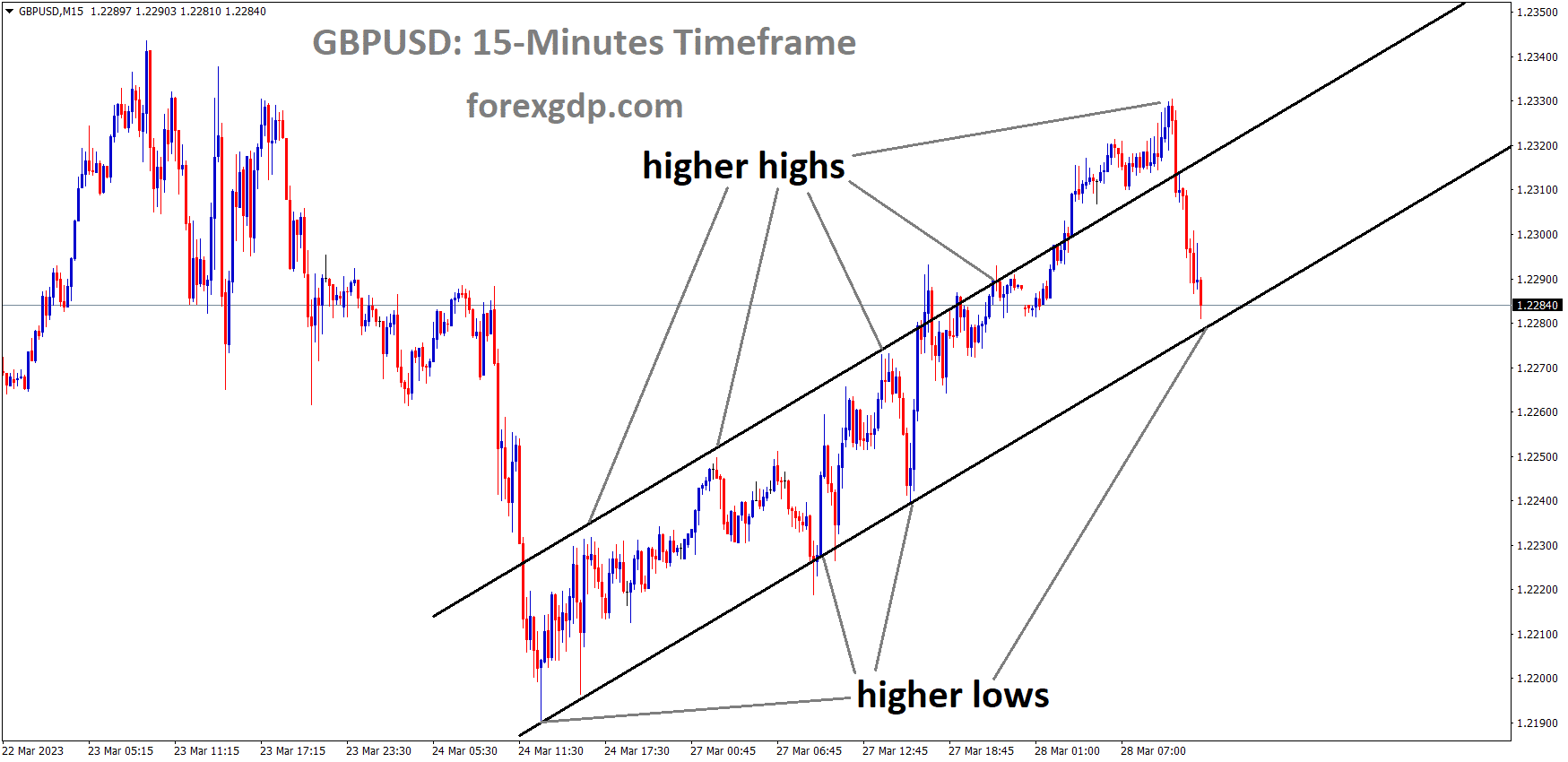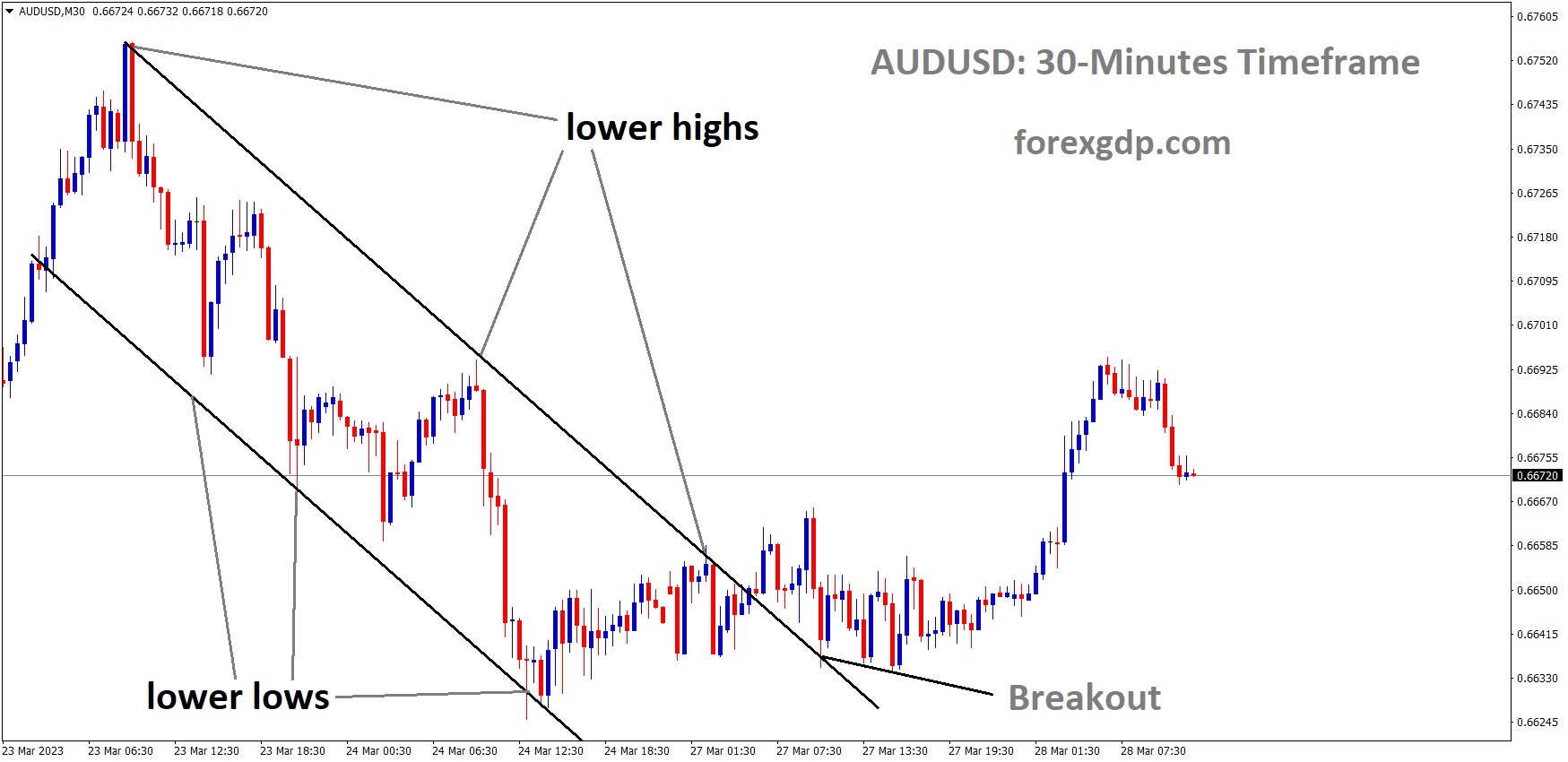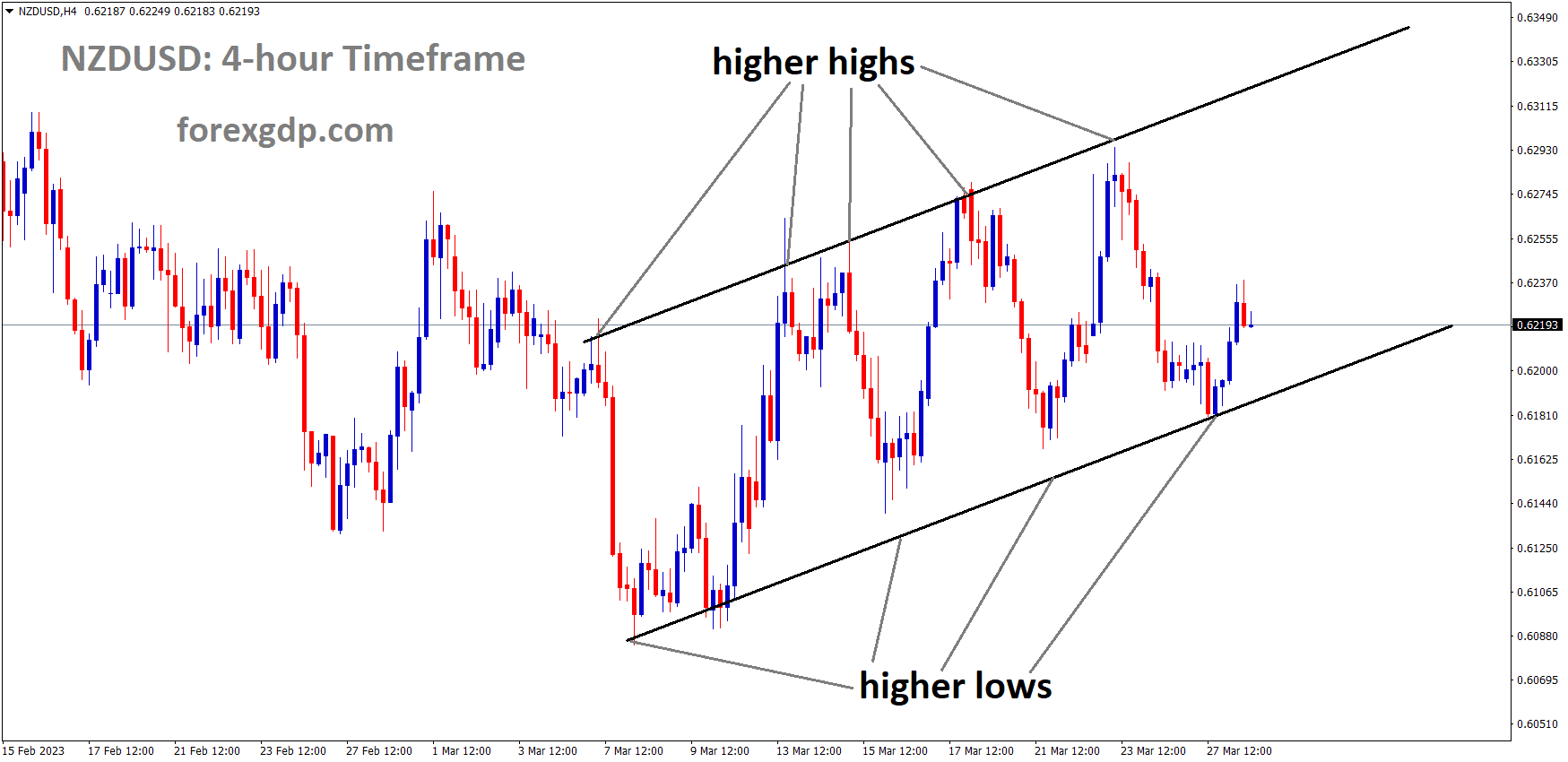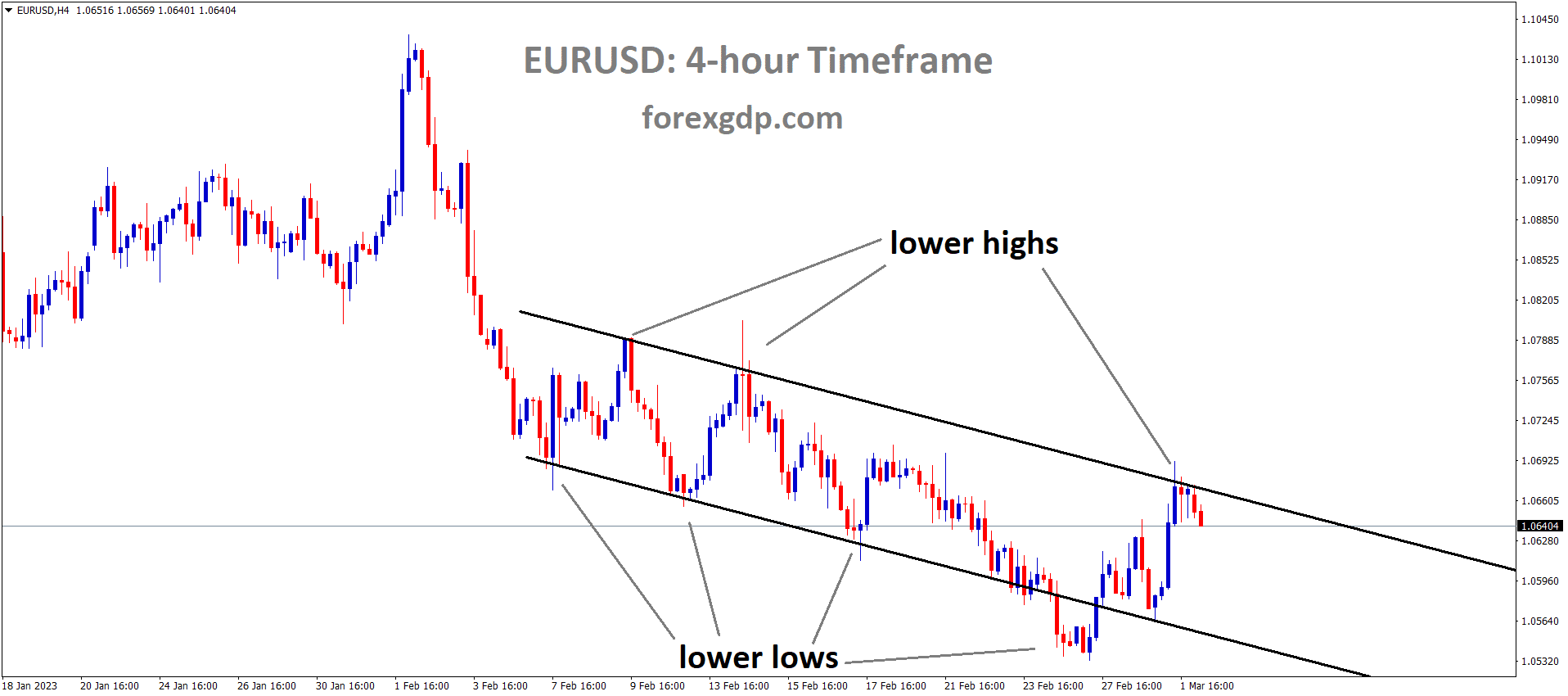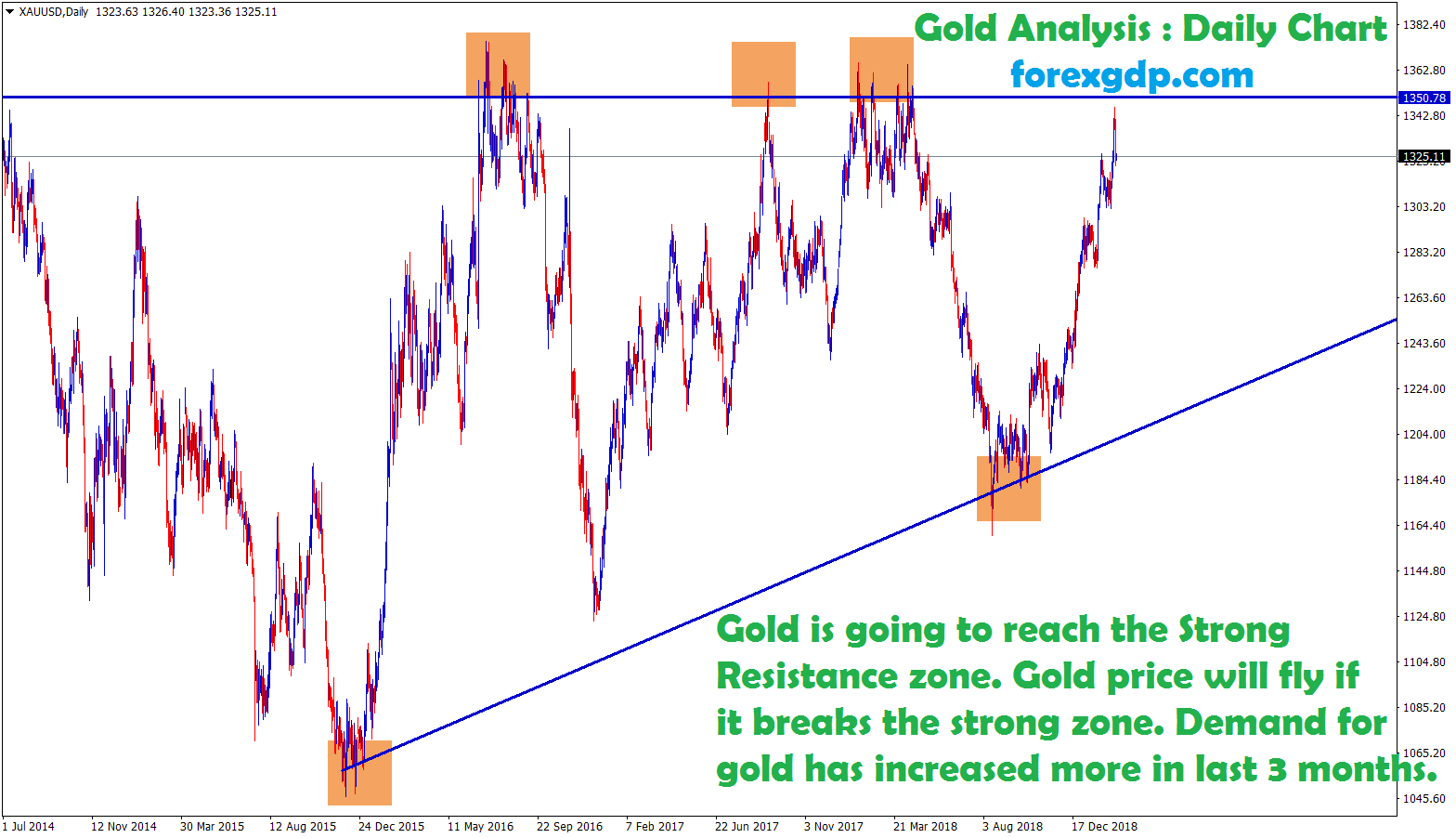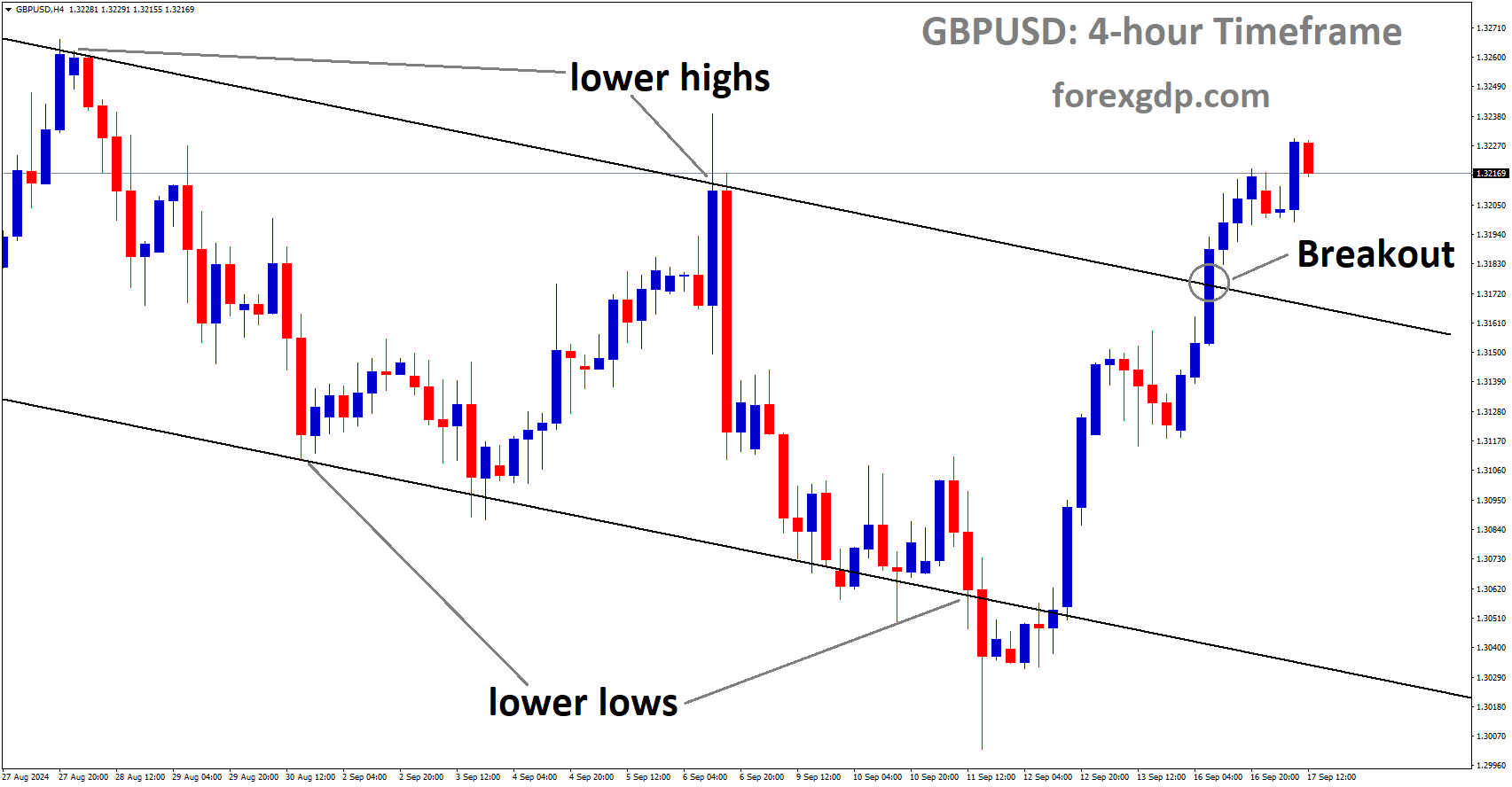GOLD Analysis
XAUUSD Gold price is moving in the Descending channel and the market has reached the lower high area of the channel.
Following First Citizen Bank’s acquisition of 80% of the failing Silicon Valley bank and the opening of 17 SVB Branches, gold prices have stabilised. Thus, only 20% of the Loss from the insolvency of SVB Financials was paid by the FDIC.
The emergency loan programme is being expanded by US authorities to help lenders with liquidity issues. This report prevents the US dollar from falling. Fears of rate increases being put on hold will encourage gold purchases and have a negative effect on the US dollar.
Monday saw a decline in gold prices as a result of higher U.S. Treasury yields and less desire for safe-haven assets. Early in the afternoon’s trading, the price of gold was about 1.5% lower at $1,955, just above the session bottom of $1,945. Following news that First Citizens Bancshares had agreed to buy significant portions of the insolvent Silicon Valley Bank from the Federal Deposit Insurance Corporation, a move that could help lower elevated uncertainty in the banking system, the market’s attitude, though still cautious, became more upbeat. Reports in the media that U.S. authorities would extend the emergency lending programme already in place to aid troubled lenders in need of liquidity also reduced the desire for defensive positions and helped calm nerves on Wall Street.
Although stabilising sentiment may limit gold’s near-term upside, precious metals are set to benefit from impending tailwinds. For instance, a bullish catalyst in the medium term should be considered the greater possibility that the U.S. economy will enter a recession in the second half of the year as a result of tighter credit conditions. Technically speaking, gold prices have repeatedly attempted to break through the $2,000/$2,005 region, but have failed. In recent days, sellers have pounced and forced reversals at every available opportunity, signalling that bulls may be retreating, at least temporarily. XAUUSD may dip a little lower before bottoming out because bullish momentum is showing obvious symptoms of exhaustion. Initial support is at $1,940, followed by $1,905. $1,880 looks to be the next downside target on further declines. Technical resistance can be found near $1,975, and $2,000/$2,005 after that, if bulls successfully retake charge of the market and ignite a strong rebound. If gold is able to decisively overcome these technical obstacles, we might soon see a rise towards $2,050.
USDJPY Analysis
USDJPY is moving in the Descending channel and the market has reached the lower high area of the channel.
According to Japanese Economy Minister Shigeyuki Goto, we will use budgetary reserves to fund a 2.2 trillion yen stimulus plan.
The financial system in Japan, according to Prime Minister Fumio Kishida, is stable and well-liquidated.
There should be no public concerns, and banks have enough cash to avoid a liquidity crisis.
Shigeyuki Goto, the minister of economy for Japan, stated on Tuesday that a stimulus plan totaling 2.2 trillion yen would be paid for out of budget reserves. Prime Minister Fumio Kishida of the nation stated that the country constantly monitors bank developments as well as the overall stability of the Japanese financial system. Japan’s financial system is generally still stable, carefully monitoring bank developments. Financial markets are exhibiting risk fear. The financial organisations in Japan have a lot of capital and liquidity.
Former Bank of Japan Board Member Sakurai stated that the incoming BoJ Governor must make adjustments to the control of the yield curve, but no alterations can be made before the month of July. Future inflation will rise to 2% gradually and steadily. Government officials must keep an eye on both local and global growth as well as the effects of wages on labour markets.
Former Bank of Japan board member Makoto Sakurai stated in an interview with MNI that “the decline in bond yields and more stable yen affords incoming Bank of Japan governor Kazuo Ueda time to consider modifications to yield curve control, but no change is likely before July as policymakers monitor domestic and global growth as well as the results of wage negotiations.
The incoming governor Ueda is well aware that if hasty action destabilises the market and prices, he will lose everything. Thus, after carefully evaluating the prognosis for the economy, prices, and the prospects for a positive feedback loop between wages and prices, he will gradually implement policy changes.
What matters most is how Japan’s economy and wages evolve over the next few months, as well as their prospects. highlighting how important wage negotiations will be in determining how the BOJ will view the question of whether the 2% inflation goal can be met in a stable and sustainable way.
USDCAD Analysis
USDCAD is moving in the Descending triangle pattern and the market has reached the lower high area of the pattern.
Future consumer spending, loan disbursements from banks, and liquidity outflow will all be slower due to constrained credit lines from US banks and reduced inflation.
Following an increase in oil prices and faster-than-expected retail sales figures on Friday last week, the Canadian dollar increased.
Due to an increase in retail sales statistics over the past month, the Bank of Canada anticipated raising interest rates.
Going into Tuesday’s European session, USDCAD bears maintain dominance around 1.3640-35, posing intraday losses of 0.17% over a two-day downtrend. As a result, the US Dollar’s widespread weakness and the most recent halt in the price of WTI Crude Oil are both unjustified by the Loonie pair. It’s important to note that WTI Crude Oil records slight losses near $72.80 while accumulating the largest daily loss in 10 months, which was recorded the day before. While the market’s cautious optimism may have contributed to the commodity’s prior uptrend, news about China appear to have something to do with its most recent downturn. In other news, the US Dollar Index is down for the second day in a row, reaching 102.65 as of press time, down 0.21% daily.
Crude Oil Analysis
Crude Oil is moving in the Descending channel and the market has rebounded from the lower low area of the channel.
The efforts of international policymakers to support the firmer sentiment and weigh on the US Dollar are supported by stretched emergency credit lines to troubled banks and deposit protection schemes. Recent remarks from central bank officials dismissing worries about the banking crisis and the Silicon Valley Bank deal strengthened the risk-on attitude. The US Treasury Department announced on Monday that it will continue to employ measures to stop the spread of financial instability. Prior to that, Fed Vice Chair for Supervision Michael Barr and Federal Reserve Governor Philip Jefferson demonstrated their preparedness to control the banking crisis while easing inflation concerns. In addition, Minneapolis Fed President Neel Kashkari had earlier raised the possibility of a US recession, which added to hawkish Fed bets’ concerns and put downward pressure on the prices of the US Dollar and USDCAD. Monday saw a decline in the US Dallas Fed Manufacturing Business Index, which for March fell to -15.7 from -10.9 anticipated and -13.5 previously.
The US 10-year and two-year Treasury yields continue to decline as of press time, paring the week’s early recovery following a three-week downtrend. This is indicative of the mood. Despite this, Asian stocks continue to rise, and the newest S&P 500 Futures results show modest gains. The main event for USDCAD pair traders to watch in the near future will be Canada’s Annual Budget Release, along with the US Conference Board’s Consumer Confidence for March and the secondary housing and activity data.
USDCHF Analysis
USDCHF is moving in the Descending channel and the market has reached the lower high area of the channel.
The continuous takeover of the major Banks by Default Banks creates trust for the Public to deposit in Private Businesses.
The public’s increased sense of security helps the Swiss Franc hold its value against other currency combinations. The UBS acquisition of Credit Suisse causes the public to lose faith in money.
In the early hours of the European session on Tuesday, the USDCHF pair rises to a new daily high after drawing some buyers near the 0.9135 area. The pair is presently trading in the 0.9180 region and has largely recovered from the losses from the previous day. A generally positive risk tone continues to be supported by diminishing concerns about a full-blown financial crisis, which in turn weakens the Swiss Franc as a safe-haven currency and strengthens the USDCHF pair. Market jitters regarding the risk of spread were eased by First Citizens Bank & Trust Company’s acquisition of Silicon Valley Bank. Additionally, regulators’ assurances that they were prepared to handle any liquidity issues helped to reverse the recent negative sentiment and increase investors’ appetite for assets that were seen as being more risky.
On the other hand, the US Dollar is still under some selling pressure for the second straight day, which may discourage traders from making aggressive bullish wagers on the USDCHF pair. The reality that the Federal Reserve softened its approach to controlling inflation continues to weigh on the USD. This turns out to be another reason weighing on the dollar, along with a slight decrease in US Treasury bond yields, and it is prudent to exercise caution before positioning for any further appreciation of the major. Market players are now anticipating Tuesday’s US economic news, which will include the Richmond Manufacturing Index and the Conference Board’s Consumer Confidence Index. In addition, the US bond yields may affect the USD price dynamics and give the USDCHF combination some momentum. In order to seize short-term opportunities, traders will also take cues from the general risk mood. The US Core PCE Price Index report, which is the Fed’s favoured inflation indicator, is due out on Friday.
USD Index Analysis
US Dollar index has broken the Descending channel in upside.
SVB Financials was purchased by First Citizen Banks for $72 billion at a discount rate, with the FDIC bearing the loss of the remaining $20 billion.( Federal Deposit Insurance corporation).
In Q2, the FED will stop raising interest rates, and at the conclusion of the year, rate cuts of 75 basis points are possible in Q3.
This morning, just before the UK market opened, First Citizen Bank announced that it had purchased the defunct US lender Silicon Valley Bank. (SVB). First Citizen has purchased about $72 billion of SVB’s assets at a discount and will take over SVB’s 17 locations with the remaining $90 billion being held by the Federal Deposit Insurance Corporation (FDIC). The failure of SVB will cause the FDIC to lose $20 billion. The financial sector gained optimism after hearing about the takeover today, turning the sector sea of green. Despite the fact that all European banks were under pressure as a result of Credit Suisse’s failure, German Bank saw a 7% rise after dropping by over 10% last Friday due to fears of contagion.
The dollar gauge is sloping downward as US markets open. A recent risk-off bid for the dollar was influenced by worries about bank contagion, so today’s shift in mood is only slightly hurting the dollar. The current market expectation is that US interest rates will stay unchanged through the end of Q2 before a rate-cutting cycle starts in Q3. The dollar is under duress as a result. This year, the Fed is expected to cut interest rates by 75 basis points. The slight shift in risk sentiment has caused the US dollar index to trade close to the 102.50 mark at the moment. This week’s deadlines for the final analysis of the US Q4 GDP and core PCE inflation data could have an impact on the US currency. The dollar index is still below all three moving averages, and the CCI indicator shows that the DXY is leaving oversold territory, creating a bearish technical setting. The upward movement on Friday and the early change today have broken a string of lower highs and lower lows, but the short-term outlook for the dollar is still uncertain.
EURUSD Analysis
EURUSD is moving in an Ascending channel and the market has reached the higher high area of the channel.
The head of the European banking authority, Jose Manuel Campa, stated that the risks in the financial industry are very high. The unrealized losses on the banking balance sheet are carefully monitored by European banking regulators.
Banks have difficulty disbursing debts due to rising interest rates.
The European Banking Authority’s Chairman, Jose Manuel Campa, issued the following warning in the German newspaper Handelsblatt: “The risks in the financial system continue very high. Financial markets were still being affected by rising interest rates. The regulator for the European Union was carefully observing unrealized losses in banks’ balance sheets.
GBPUSD Analysis
GBPUSD is moving in an Ascending channel and the market has reached the higher low area of the channel.
In light of recent Brexit news and tight labour markets, BoE Governor Andrew Bailey’s address on the UK economy raises expectations. Once interest rates are raised in response to changing economic conditions, an inflation crisis will result.
GBPUSD advances favourably in anticipation of BoE Governor Bailey’s address.
GBPUSD re-reaches its intraday peak around 1.2320 ahead of Tuesday’s London market open as risk-taking sentiment and price-positive UK news stories entice Cable buyers. The anticipation of hearing hawkish remarks from Bank of England Governor Andrew Bailey, particularly after he said the same thing the day before, may have contributed to the quote’s upward momentum. Observing ongoing inflationary pressures on Monday, BoE’s Bailey added, “If they become evident, further monetary tightening would be required.” The Brexit barriers and labour issues that have lately threatened the British economy could give the Cable pair’s advancements additional traction and raise expectations of further inflation pressure.
On the other hand, the efforts made by international policymakers to support the stronger sentiment and weigh down the US Dollar through deposit protection schemes and stretched emergency credit lines to troubled banks drive up the price of the GBPUSD. Recently adding strength to the risk-on mood and weighing on the greenback are comments from the central bank officials pushing back the banking crisis concerns and the Silicon Valley Bank deal. However, the US Treasury Department stated that the country will continue to employ tools as required to prevent banking contagion. Prior to that, Fed Vice Chair for Supervision Michael Barr and Federal Reserve Governor Philip Jefferson demonstrated their preparedness to control the banking crisis while easing inflation concerns.
It’s important to note that the recent negative US data pressured the hawkish Fed bets, particularly after earlier hints of a US recession from Minneapolis Fed President Neel Kashkari, and weighed down the US Dollar. Monday saw a decline in the US Dallas Fed Manufacturing Business Index, which for March fell to -15.7 from -10.9 anticipated and -13.5 previously. In light of this, the US 10-year and two-year Treasury yields are pushing a week-start recovery after experiencing a three-week downtrend, grinding near 3.52% and 3.98%, respectively, as of the time of press. In spite of this, equities in the Asia-Pacific region experienced mixed trading, while S&P 500 futures have recently posted modest gains. In order to keep buyers in control, GBPUSD bulls will look for more hawkish remarks from BoE’s Bailey as well as weaker readings of the US Conference Board’s Consumer Confidence for March.
AUDUSD Analysis
AUDUSD has broken the Descending channel in Upside.
Australian MoM Retail sales for February were 0.20 % versus 0.10 %, but they were still lower than the 1.8% figure for January.
This retail sales data reveals consumers’ tightening spending patterns and increased scepticism regarding the RBA rate rise at the April Meeting.
In the Asian session, the AUDUSD gained momentum with a retest of the 0.6700 level, aided by slightly better-than-expected retail sales data. The preliminary MoM retail sales data showed a sharp decline from the 1.8% figure in January but came in at 0.2% versus expectations of 0.1%. The US Dollar’s lacklustre start to the week and an increase in risk sentiment have both benefited the Australian Dollar.The retail sales print might be a sign of the lagging effects of the Reserve Bank of Australia’s rate increases and a signal that consumers are controlling their spending. Given the domestic as well as the global environment, this makes the argument for a pause from the RBA at its upcoming April meeting all the more compelling.
We do have a lot of economic event risk coming up this week, beginning with the US CB Consumer Confidence data released today and continuing through the GDP and the Fed’s preferred inflation measure, the Core PCE numbers, which are scheduled to be released on Thursday and Friday, respectively. On the Australian front, tomorrow’s release of the CPI figures could further support a pause from the RBA, while a higher-than-expected number might cause those bets to lose steam before the April meeting.
NZDUSD Analysis
NZDUSD is moving in an Ascending channel and the market has rebounded from the higher low area of the channel.
The anticipation that the RBNZ will increase the rate by 25 basis points to 5.00% at the next meeting caused the New Zealand Dollar to recover from its lows. When rate increases are stopped or priced more slowly, the economy slows down.
If a rate increase occurs in May, ANZ Bank forecasted a cash rate of 5.2% for May.
During missile training, a Russian Pacific Fleet ship launches missiles at an enemy target beneath the Sea of Japan.
After holding the 0.6180 support, the NZDUSD pair experienced a swift rebound. In the early European session, the Kiwi asset has extended its rebound perpendicularly above 0.6230. The Kiwi asset’s positive bias depends on the US dollar’s depreciation. After finding temporary support at around 102.60, the US Dollar Index has started to decline again. The USD Index has fallen even further as investors have reduced their hopes for the Federal Reserve to maintain its current monetary policy at its policy meeting in May. More than 60% of the time, according to the CME Fed watch tool, the monetary policy will remain unaltered.
The general public believes that the United States’ commercial banks’ strict credit policies will be enough to moderate inflation going forward. In light of the potential harm to the forecast for the economy, Fed Chair Jerome Powell will refrain from raising interest rates. After a three-day gaining streak, S&P500 futures are now choppy. In the meantime, tensions around the world have increased after the Russian Defense Ministry claimed that Pacific Fleet missile ships launched Moskit cruise missiles at a fictitious enemy sea target in the Sea of Japan, according to Reuters. The risk propensity is still high, and the risk profile has not changed.
On the front of the New Zealand Dollar, bleak economic predictions following the flood scenario have prompted worries about the growth rate. At its Monetary Policy Review on Wednesday, the Reserve Bank of New Zealand is expected to increase the Official Cash Rate by 25 basis points to 5.00%, according to ANZ Bank analysts. The slowdown in rate increases is ideal for the sputtering economy. According to the ANZ Bank analysis, the OCR will peak at 5.25% with one more increase planned for May.
Don’t trade all the time, trade forex only at the confirmed trade setups.
Get more confirmed trade setups here: forexgdp.com/buy/

